Economics 2020 JAMB CBT Questions
Economics 2020 JAMB CBT Questions
1. The privatization of public enterprises will lead to efficient management of resources in the economy. This statement can best be described as_____________
- A. deductive reasoning
- B. positive reasoning
- C. normative reasoning
- D. inductive reasoning
2.The type of business finance that entitles the holder to a fixed rate of dividend is______________--
- A. bank load
- B. debenture
- C. preferred stock
- D. semi-fixed
3. In the long run, all production factors are____________
- A. variable
- B. fixed
- C. semi-variable
- D. semi-fixed
4.Commercial bank reserves at the Central Bank____________
- A. advancing trade, prospects
- B. controlling credit and money supply
- C. reducing bank frauds
- D. discouraging banking operations
5.If the standard deviation of a given data is 8.2, find its variance_______________
- A. 82.0
- B. 91.8
- C. 67.2
- D. 4.1
6. The ultimate objectives of economics is to_________?
- A. decide under what circumstances that government should intervene in the economy
- B. Organize production at the lowest cost
- C. Make the best use of scarce resources
- D. make efforts to understands how the economy works
7.The savings deposit in a commercial bank is called____________?
- A. near money
- B. call money
- C. capital
- D. fund
8.A major determinant of the demand for a luxury good is____________?
- A. the price of other goods
- B. the price of the good
- C. tastes and fashion
- D. the income of consumers
9.When a variable is associated with time period, it is_____________
- A. circular
- B. a flow
- C. static
- D. a stock
10.The factor of production that has the highest degree of mobility is__________?
- A. entrepreneurship
- B. land
- C. labour
- D. capital
Correct Answer: Option C
11.The minimum number of share holders for joint stock companies is_______________
- A. 4
- B. 2
- C. 7
- D. 3
12. If a demand curve that intersects a perfectly inelastic supply curve shift is rightward, then____________
- A. only the quantity will increase
- B. The prices will remain constant
- C. the equilibrium price and quantity will increase
- D. only the price will increase
Correct Answer: Option C
13. The basic economic problems of society include___________
- A. scarcity, for whom to produce and where
- B. what to produce, how and for whom
- B. scarcity, when to produce and how
- D. how to produce and sell
14. In an open economy, the GNP is measured as_____________?
- A. C + 1 + G(X-M)
- B. C + 1 + G
- C. C + 1 + G + X
- D. C + 1 + G + M
Correct Answer: Option A
15. In a developing economy, productivity is measured by the____________
- A. output - labour ratio
- B. capital - output ratio
- C. output growth rate
- D. Output per capital
16. The need to construct a scale of preference is necessitated by____________
- A. scarcity and the need for choice
- B. The needs to satisfy wants
- C. Non - availability of factors of production
- D. Scarcity of resources
17. The privatization exercise in Nigeria is a move towards a____________
- A. command economy
- B. mixed economy
- C. subsistence economy
- D. market economy
Correct Answer: Option D
18. The mean is the best measure of central tendency because it__________
- A. can be calculated from incomplete data
- B. is a balancing point in an observation
- C. is a midpoint value in an array of data
- D. is not affected by extreme values in a data
19
| No of Men | 0 | 1 | 2 | 3 | 4 | 5 | 6 | 7 | 8 |
| Total Product(unit) | 200 | 440 | 540 | 600 | 640 | 660 | 660 | 640 |
- A. N110
- B. N120
- C. N220
- D. N330
20
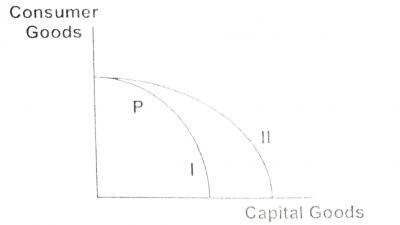
The current stage of the economy is depicted in curve I. The movement of curve I to II suggests___________
- A. an Improvement in capital goods technology but not In consumer goods technology
- B. a movement from unemployment to full employment
- C. that the output for the society has declined
- D. a gain in consumer goods technique and not in capital goods technique
21.When elasticity is zero, the demand curve is_____________
- A. circular
- B. downward sloping
- C. perfectly inelastic
- D. concave
22. Which of the following is not a direct tax?
- A. capital gains tax
- B. purchase tax
- C. personal income tax
- D. capital tax
Correct Answer: Option B
23. A limited liability company is owned by________________
- A. a bank
- B. an individual
- C. two or more partners
- D. share holders
Correct Answer: Option D
24. If the price
of a ball point pen falls from N1.00 to No.60 and the quantity demanded
increases. from 200 to 300, the point elasticity of demand is equal
to____________
- A. 0.50
- B. 0.40
- C. 1.25
- D. 0.80
25. If the price elasticity of demand for a good is 0.43 an increase in the price of the good will result in____________
- A. a decrease in profit by 43%
- B. an increase in profit by 43%
- C. a net loss
- D. a net gain
26. The money paid per hour for work done is_________
- A. cost
- B. salary
- C. bonus
- D. wage rate
27
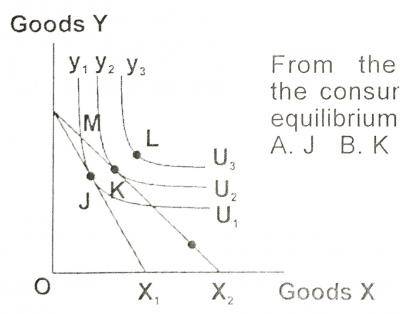
From the graph above the consumer will attain equilibrium at point_______________
- A. J
- B. K
- C. M
- D. L
Correct Answer: Option B
28. By utility we mean____________
- A. beneficial
- B. power of satisfying a want
- C. advantageous
- D. consumable
Correct Answer: Option B
29. Concentrating industries in one place is advantageous because there are gains in terms of_____________
- A. cost economies
- B. economies of scale
- C. internal economies
- D. external economies
Correct Answer: Option B
30. The effects on the demand for product A caused by a change in the price of product B is Called____________
- A. Joint demand
- B. cross-elasticity of demand
- C. elasticity of supply
- D. competitive demand
31. An upward movement along the same supply curve result in_____________
- A. a decrease in price
- B. an increase
- C. an increase in quantity supplied
- D. a decrease In quantity supplied
32. The coefficient of the price elasticity of supply is always_____________
- A. Constant
- B. Zero
- C. Positive
- D. Negative
Correct Answer: Option C
33. In the history of economics the concept of division of labour is usually associated With______________-
- A. Karl Marx
- B. Adam Smith
- C. David Ricardo
- D. J.M Keynes
34. Given that Y = C + 1, where C = 50 + 0.75 and 1 = N45m, what is the equilibrium level of income?
- A. N20m
- B. N380m
- C. N200m
- D. N180m
Correct Answer: Option B
35
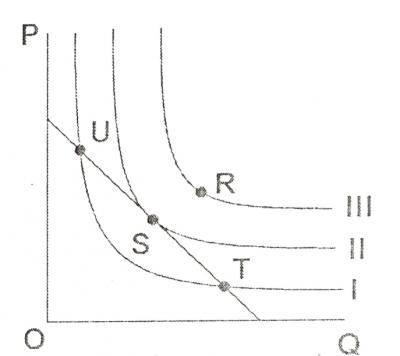
From the diagram shown, the optional point of production is_____________?
- A. R
- B. T
- C. S
- D. U
36. An ad valorem tax is imposed on_____?
- A. Exports
- B. Imports
- C. The Value of a Commodity
- D. Special Commodities
Correct Answer: Option C
Explanation
An ad valorem tax (Latin for "according to value") is a tax whose amount is based on the value of a transaction or of property. It is typically imposed at the time of a transaction, as in the case of a sales tax or value-added tax (VAT).
37. The labour force of a country is determined by the___________
- A. geographical distribution of the population
- B. age structure of the population
- C. number of people available for work
- D. sex distribution of the population
38. The transfer of public share holding in corporations to private enterprise is___________?
- A. Incorporation
- B. Concession
- C. Privatization
- D. Commercialization
39. An economy in which both the public and private sectors contribute to economic growth is a__________?
- A. socialist economy
- B. feudal economy
- C. mixed economy
- D. capitalist economy
40.A capital market differs from the money market in that in the former ________?
- A. The percentage of interest charged is more
- B. Loan sought is long term
- C. Loan repayment is guaranteed
- D. Loan sought is short-term
Correct Answer: Option B
Explanation
Basically the difference between the capital markets and money markets is that capital markets are for long term investments, companies are selling stocks and bonds in order to borrow money from their investors to improve their company or to purchase assets. Whereas money markets are more of a short term borrowing.41. The reduction in the value of a country’s currency in relation to the value of the currencies of other nation is known as____________
- A. Deflation
- B. Inflation
- C. Devaluation
- D. Revaluation
42
| X | 8 | 10 | 12 | 16 | 18 | 20 | 24 |
| F | 2 | 1 | 4 | 3 | 3 | 1 | 6 |
From the table, Calculate the median___________
- A. 24.0
- B. 17.0
- C. 18
- D. 16
Correct Answer: Option D
Median=[(N+1)/2]th
For member of odd number items. That is, where N is odd
Median=([N/2[N/2+1]th)/2
For member of odd number items. That is, where N is odd
Solution:
When a group data is involved, cumulative frequency is used. The formula will be:
Median=[(N+1)/2]th
For member of odd number items. That is, where N is odd
Median=([N/2[N/2+1]th)/2
For member of odd number items. That is, where N is odd
Solution:
Explanation
When a group data is involved, cumulative frequency is used. The formula will be:Median=[(N+1)/2]th
For member of odd number items. That is, where N is odd
Median=([N/2[N/2+1]th)/2
For member of odd number items. That is, where N is odd
Solution:
| X | 8 | 10 | 12 | 16 | 18 | 20 | 24 |
| F | 2 | 1 | 4 | 3 | 3 | 1 | 6 |
| Cumulative Frequency | 2 | 3 | 7 | 10 | 13 | 14 | 20 |
When a group data is involved, cumulative frequency is used. The formula will be:
Median=[(N+1)/2]th
For member of odd number items. That is, where N is odd
Median=([N/2[N/2+1]th)/2
For member of odd number items. That is, where N is odd
Solution:
43. The expression of cost in terms of alternative forgone is referred to as ____?
- A. Scarce resources
- B. Decision making
- C. Opportunity cost
- D. Choice
Correct Answer: Option C
Explanation
Opportunity cost is defined as the expression of cost in terms of alternative forgone. It is the satisfaction of one’s want at the expense of another want.
44. The full meaning of NAPEP is?
- A. National Poverty Eradication Programme
- B. National Agency for Poverty and Education Program
- C. National Air Pollution and Environmental Purification
- D. None of the above
Correct Answer: Option A
Explanation
National Poverty Eradication Programme (NAPEP) is a 2001 program by the government aimed at poverty reduction, in particular, reduction of absolute poverty. NAPEP goals include training youths in vocational trades, to support internship, to support micro-credit, create employment in the automobile industry and help VVF (Vesico-vaginal fistula) patients.
45. Taxes and government expenditures are instruments of____________
- A. Monetary policy
- B. Tax policy
- C. Economic policy
- D. Fiscal policy
Correct Answer: Option D
Explanation
Fiscal policy may be defined as the use of income and expenditure instruments or policies to control or regulate the economic activities in a country. It is a plain action by government pertaining to the raising of revenue through taxation and other means and the pattern of expenditure to be applied.
46. As a factor of production, the reward for land is?
- A. Profit
- B. Interest
- C. Rent
- D. Wage
Explanation
As factors of production, the reward for land is rent, capital is interest, labour is wages and salaries and entrepreneur is profit.Rent is the reward for Land as a factor of production
47
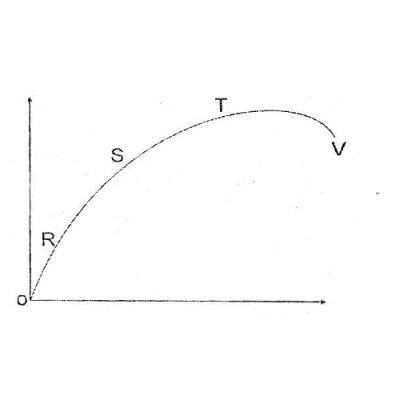
The diagram below represents a production function. At which of the points does diminishing returns set in__________
- A. R
- B. S
- C. T
- D. V
Correct Answer: Option C
Law of diminishing returns states that as more units of a variable input are added to fixed amounts of land and capital, the charge in total output will first rise and then fall.
Explanation
Production function refers to the functional relationship between the quantity of a good produced (output) and the factors of production (inputs). The production function relates the maximum amount of output that can be obtained from a given number of inputs.Law of diminishing returns states that as more units of a variable input are added to fixed amounts of land and capital, the charge in total output will first rise and then fall.
48. The two major types of international trade are Bilateral trade and?
- A. Internal trade
- B. Multilateral trade
- C. Dilateral trade
- D. Trilateral trade
49
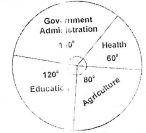
A country's budget allocation to various sectors of the economy is shown in the pie chart .
If the budget of the country was $7,200.00, how much is allocated to education?
If the budget of the country was $7,200.00, how much is allocated to education?
- A. $2,400.00
- B. $2,000.00
- C. $1,200.00
- D. $1,000.00
Correct Answer: Option B
Explanation
Multilateral trade is a type of international trade in which a country trades with many other countries. This ensures international division of labour. It is the type of trade in which many countries exchange their goods and services
50. In a capitalist economy, factors of production are owned and controlled by the _____?
- A. Citizen
- B. Business Men
- C. Government
- D. Foreigners


